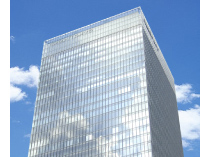-
-
- Reduction of the lighting in the common areas.
- Reduction of lighting in the exclusively-owned areas by turning down (or partly turning off) lights using motion sensors.
- Optimization of air conditioner temperature in the common areas.
- Reduction on operating time of the electric ventilation fans and the air conditioners in each room.
- Adjustment (optimization) of each heating equipment.
- Reinforcement of the steam duct and valve heat insulation.
- Lowering the temperature setting of the hot water supply systems.
- Intermittent operation of the toilet seat heaters.
|
 |
CO2 emission from Gran Tokyo North Tower is relatively large due to the size of the building and its purposes. However, as a measure against global warming, we are endeavoring to reduce CO2 emission by cooperating with our tenants.
| The figures September, 2024. |
|
 |
(tonnes of CO2)
| |
Apr |
May |
Jun |
Jul |
Aug |
Sep |
Oct |
Nov |
Dec |
Jan |
Feb |
Mar |
Total |
| 2021 |
2,039 |
2,030 |
2,227 |
2,592 |
2,657 |
2,325 |
2,055 |
1,965 |
2,116 |
2,122 |
1,942 |
2,050 |
26,120 |
| 2022 |
1,998 |
2,035 |
2,227 |
2,661 |
2,821 |
2,491 |
2,080 |
1,975 |
2,056 |
2,087 |
2002, |
2,071 |
26,504 |
| 2023 |
1,998 |
2,034 |
2,227 |
2,663 |
2,823 |
2,496 |
2,079 |
1,977 |
2,059 |
2,090 |
1,994 |
2,056 |
26,497 |
| 2024 |
1,995 |
2,046 |
2,166 |
2,746 |
2,819 |
2,508 |
|
|
|
|
|
|
14,280 |
|
★Notes
The emissions shown above are calculated based on Tokyo Metropolitan Ordinance on Environmental Preservation.
The emissions shown are values before verification by Tokyo Metropolitan was conducted and so may be changed.
<Reduction of the heat load of the building>
| Reduction of the heat load of the building |
- Installing longitudinal ribs with sunshade screen effect to the curtain wall.
- Adoption of air flow windows with pair glass for the outer side on the sides facing east, west and south, and only pair glass on the side facing north where solar radiation load is relatively low to reduce heat load.
- Mitigating heat load caused by solar radiation with the automatic control system that calculates optimum values of blind slat angles, etc, using the solar altitude and the skylight illumination.
|
<Energy saving>
| Air conditioners |
- Efficient use of ice storage by using freezers.
- And at the same time, load-leveling of city infrastructures.
- Recycling the heat discharged from the department store for heating.
- Recycling the heat discharged from the department store for heating.
- Reducing water transportation power using inverter pumps.
- Reducing air conditioner transportation power using inverter fans.
- Reducing cooling load during mid-seasons by cooling with external air.
- Prevention of interior perimeter mixing energy loss using perimeterless systems.
|
| Ventilation |
- Reduction of ventilation energy consumption using local ventilation method (appropriate division of ventilation area).(Toilets, water heating)
- Controlling ON/ OFF of the ventilation fans using temperature sensors.(the electric room, the elevator machine room)
|
| Lighting |
- Extensive use of Hf fluorescent lamps and compact fluorescent lamps.
- Energy saving combining zone control systems using human absence detection with the security system, automatic ON/OFF control by brightness sensing, optimum lighting control, time schedule control,illuminance control using daylight, motion sensors.
- Utilizing light reflected on the top surface of slats by automatically controlling blinds.
|
| Hot water supply |
- Prevention of heat loss by the individual hot water supply method.
|
| Elevators |
- Optimum operation control by inverter control and group management.
|
| Energy management system |
- Energy management by monitoring efficiency of key equipments by per purpose measurement, equipment data collection and adoption of BEMS.
|
| Water supply and drainage |
- Treatment of miscellaneous wastewater, kitchen wastewater and rain water to recycle them for toilet flushing.
- Use of sanitation equipments such as water saving toilets and wash basins.
|
<Eco materials>
- Use of Type B Portland Blast-furnace Slug Cement for underground structures, etc.
- Use of recycled steel for binding beam materials, etc.
- Optimization of construction/disassembly efficiency by using module interior materials such as ones used for the grid ceiling system, etc.
- Use of ozone layer damage- free coolant.
- Use of eco-cables in spots where frequent cable change is required.
|
|